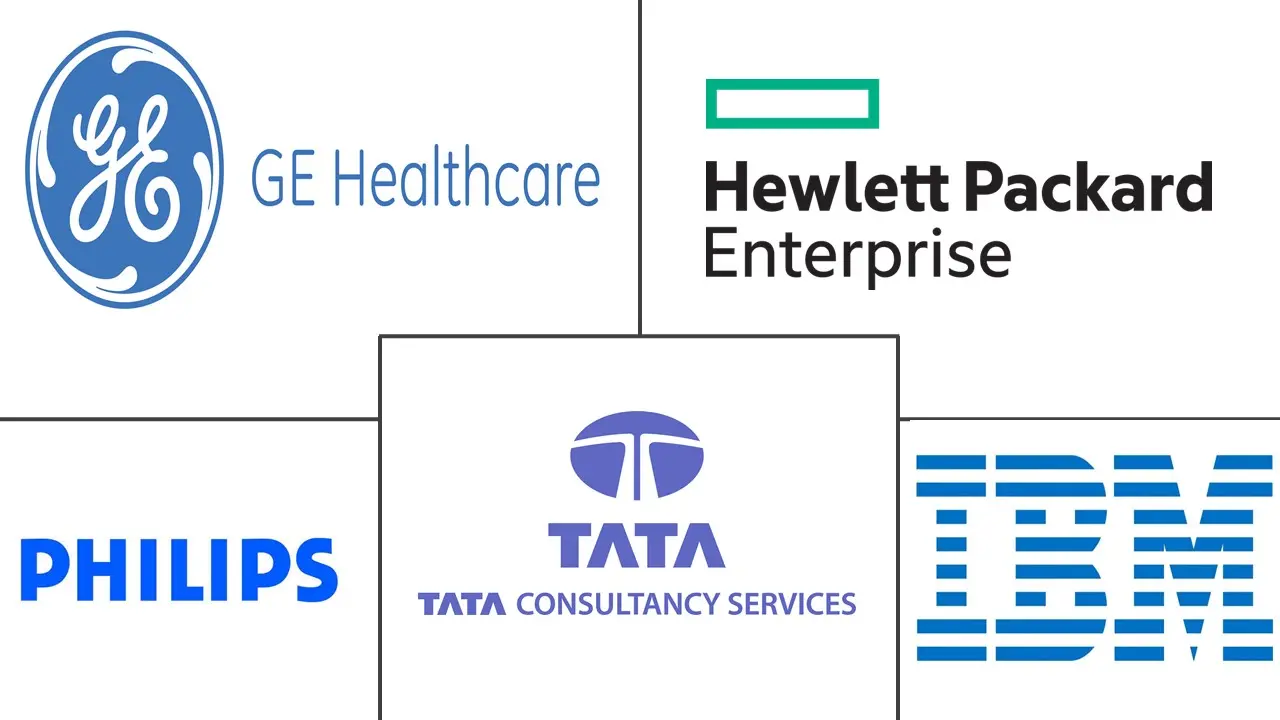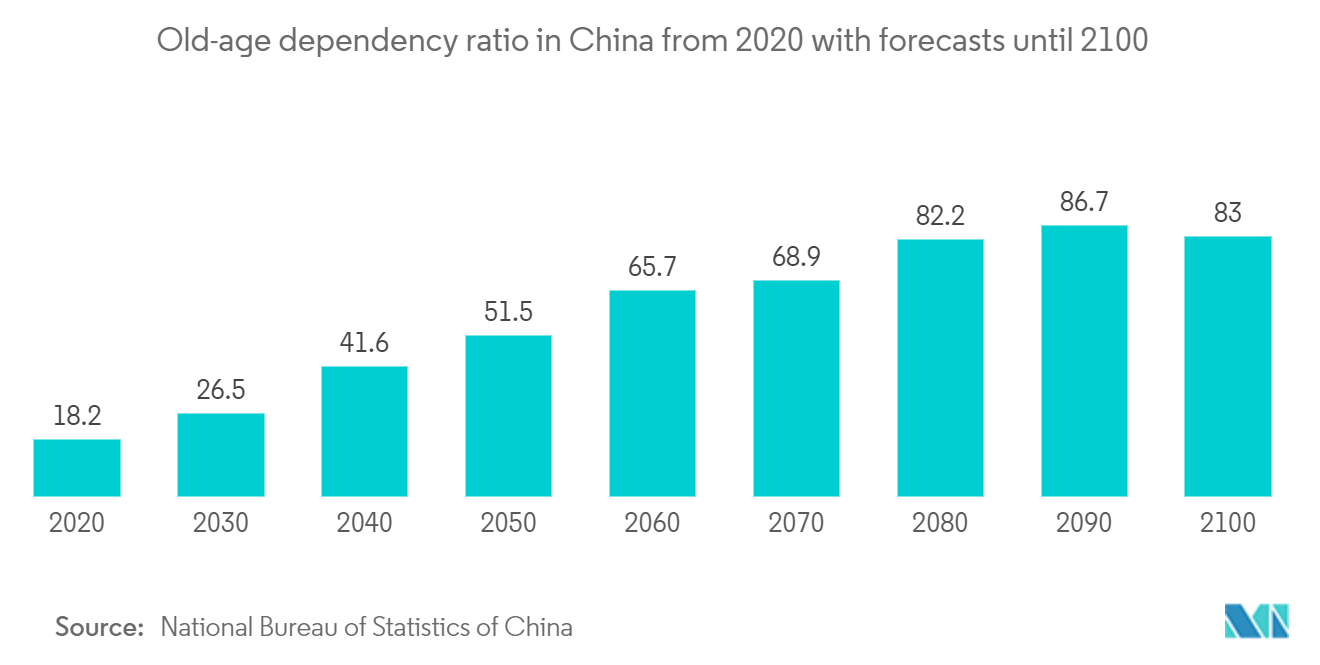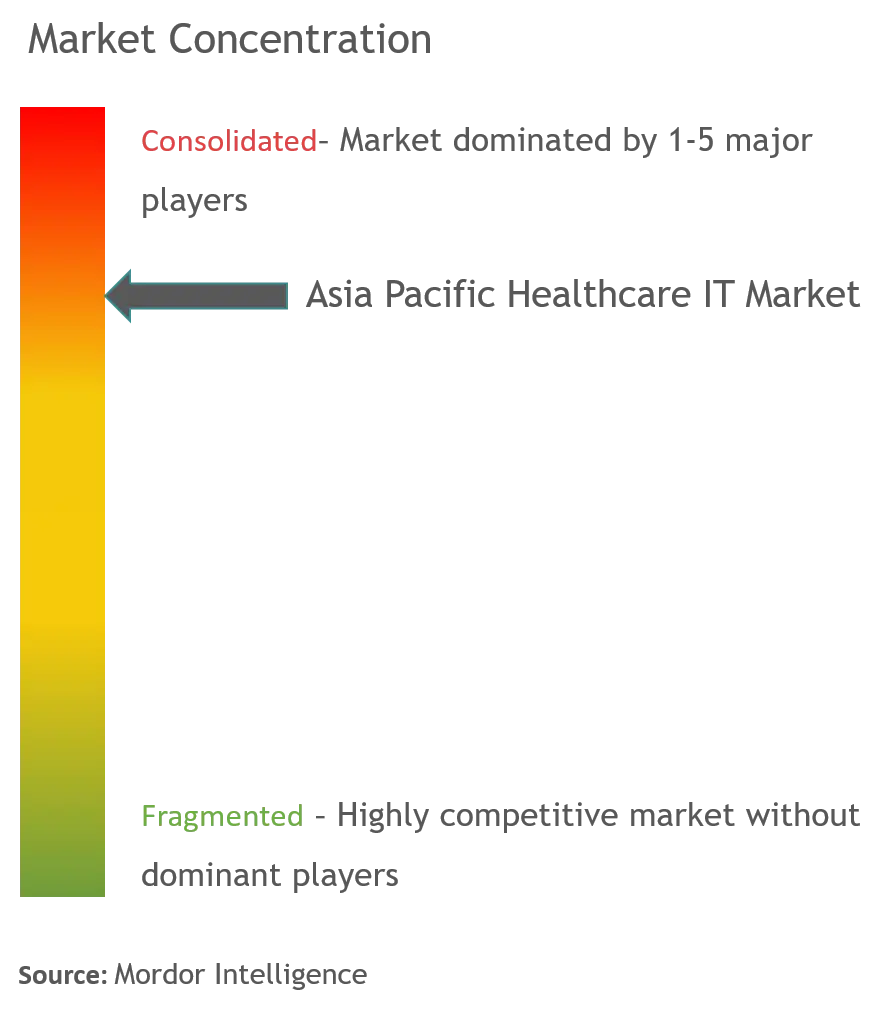APAC Healthcare IT Market Size

| Study Period | 2019 - 2029 |
| Base Year For Estimation | 2023 |
| Forecast Data Period | 2024 - 2029 |
| Historical Data Period | 2019 - 2022 |
| CAGR | 8.50 % |
| Market Concentration | High |
Major Players
*Disclaimer: Major Players sorted in no particular order |
APAC Healthcare IT Market Analysis
The Asia Pacific healthcare IT market is expected to register a CAGR of 8.5% during the forecast period. The growing demand for remote patient monitoring solutions, owing to the aging population and long-term chronic disease conditions, is the primary factor impacting the growth of the market.
- There has been an increased usage of technology in the healthcare sector to improve the workflow of nursing staff, and hospitals are equipping nurse ID badges with an RFID tag that works with the hospital's Wi-Fi network. These tags track the movement of the nurses throughout their shifts. The data is captured and analyzed, providing insights to the hospital to improve the processes. Also, there is constant pressure on hospital administrators to lower costs while continuing to improve the level of patient care. Hospitals are turning to modern technologies and analytics in this environment to operate more efficiently, support patient care, and improve their experience. This is further driving the growth of the healthcare IT market in the Asia Pacific.
- Moreover, governments are taking initiatives to set up new and advanced healthcare facilities in developing countries to cater to the requirements of the growing population. The rise in the number of healthcare facilities will increase the demand for advanced medical equipment, which is expected to drive the Asia Pacific healthcare IT market. Additionally, technological advancements in healthcare equipment, growing incidences of chronic diseases, and the rising demand for portable and home-based devices are also driving the growth of the healthcare IT market in the region.
- The market is also witnessing various key mergers, acquisitions, and investments by key players as part of its strategy to improve business and their presence to reach customers and meet their requirements for various applications. For instance, in June last year, Fujitsu and Salesforce Japan Co., Ltd. declared the start of a collaboration to create new digital solutions for the healthcare sector in the entire Japanese market. The two companies would cooperate with insurance companies and medical institutions to assist in developing insurance products that optimize the total risk assessment of diseases by individuals based on data such as the possibility of diseases predicted by AI from medical and health data.
- However, the high cost of medical supply devices and strict government regulations and guidelines restrain the market's growth.
- COVID-19's economic impact in the Asia-Pacific caused a distinct bifurcation between public and private health systems. Private health systems are finding ways to replace revenues lost to local and international travel restrictions. Moreover, public health systems increasingly focus on value-driven outcomes as they respond to the COVID-19 pandemic's extraordinary demands. Furthermore, governments are diverting funds to healthcare and economic stimuli. With widespread lockdowns and patients being increasingly hesitant to go to clinics or any clinician for fear of COVID-19 infection, many patients have turned to telehealth and telemedicine as an alternative to in-person healthcare visits.
APAC Healthcare IT Market Trends
This section covers the major market trends shaping the APAC Healthcare IT Market according to our research experts:
Patient Based Systems (Remote Healthcare, Wearables etc.) is Expected to Hold the Largest Market Share
- Wireless technology creates highly connected healthcare environments that can help hospitals address and monitor healthcare-related challenges. It is also playing a critical role in reshaping the future of healthcare for both patients and healthcare professionals. In the connected hospitals, connecting medical devices to EHR (Electronic Health Records) systems reduced the time it takes to enter the vitals from 7-10 minutes to less than 1 minute per patient.
- The adoption of remote healthcare and wearable devices in this sector has been gaining traction over recent times, which, in turn, has been one of the significant factors influencing the healthcare IT market. The major trends in wearable connected devices include increasing demand for pain management wearable devices, increasing use of wearables for cardiovascular disease management, and many others.
- Moreover, on account of advancements in healthcare technology, the growth of wearable devices with multiple biosensors monitoring several parameters witnessed a significant increase. These advances also enable the collecting, transferring, and storing of real-time data in the cloud, aiding healthcare professionals (HCPs) to predict and adjust precise and accurate drug dosage levels.
- Furthermore, the market is seeing various partnerships and collaborations from various key significant market players. For instance, in May last year, Tohoku University's Tohoku Medical Megabank Organization, pharmaceutical firms Daiichi Sankyo and Takeda Pharmaceutical Co., and medical IT company MICIN started a collaborative research project to track long-term lifestyle habits to drive the overall creation of new drugs. Over a year, they also intend to collect detailed and objective lifestyle data, such as sleep status, heart rate, and activity level.
- Per Cisco Systems, the wearables used in North America and Asia Pacific are forecast to account for around 70 percent of the wearable 5G connections worldwide in the last year. Hence, with the surge in the overall usage of wearables in the Asia-Pacific region, the Asia-Pacific Healthcare IT Market market is expected to witness significant growth opportunities throughout the forecast period.

China is Expected to Hold a Significant Market Share
- China plays a significant role in terms of augmenting the overall growth of the market significantly. The growing elderly population and rising life expectancy, increasing adoption of IoT-based medical devices, burgeoning healthcare expenditure, and accelerating demand for digital healthcare solutions due to COVID-19 are some of the major factors driving the healthcare IT market in the country.
- Government-led initiatives, such as "Internet + Healthcare" and state-level AI strategy, have accelerated the new-tech applications in China's medical sector. It is expected to continue further during the forecast period. During the COVID-19 pandemic, the Chinese government stepped up the "Internet + Healthcare" efforts to include telemedicine in state medical insurance coverage, lifted barriers for prescribed drugs sold online, and facilitated prescriptions shared to pharmacies by hospitals.
- Moreover, China faces challenges due to rapidly increasing medical demand and the shortage of healthcare resources. The application of telemedicine (i.e., remote clinical services), medical AI, and healthcare robotics has the potential to improve efficiency and clinical results, thereby creating a massive scope for growth for the market throughout the forecast period.
- In May last year, Telecommunications firm China Mobile Hong Kong, together with the health tech company Heals Healthcare, launched its mobile health app for teleconsultations in Hong Kong. The new app called Dr. HK, available on iOS and Android devices delivers a proper mix of offline and online health services, involving access to various electronic health records, video consultations, online outpatient clinic appointments, and medicine delivery. Moreover, on the app, the users can easily view the overall status of clinic queues and opening times in real-time to search for the health service most suitable for their various crucial needs.
- As per the National Bureau of Statistics of China, in 2020, the old-age dependency ratios in China ranged at around 18.2%, and it is forecasted that the overall ratio will rise to approximately 83% by 2100, indicating a steady rise in the coming decades. This will provide ample growth opportunities for the entire market to expand during the forecast period.

APAC Healthcare IT Industry Overview
The Asia Pacific healthcare IT market, which is highly competitive, consists of a number of major players. Companies such as Philips Optum (UHG), Allscripts, GE Healthcare, IBM Corporation, Tata Consultancy Services, McKesson Corporation , and Hewlett-Packard , among others, hold a substantial market share in the medical power supply market. In January 2023 - Dozee declared that its initiative MillionICU has partnered with British International Investment (BII), the UK's development finance institution (DFI) and impact investor, to upgrade around 6000 hospital beds in approximately 140 public hospitals across India and in other regions to transform the overall public healthcare landscape. In August 2022, CureApp, a Japanese medical technology firm, is getting 7 billion yen (USD 51.4 million) in investment from global investment firm Carlyle as a crucial part of their strategic partnership. The latest funds, which form part of the company's Series G funding round, would support the rollout of CureApp's prescription DTx app for the treatment of hypertension. It would also help augment the total development of its pipeline DTx apps.
APAC Healthcare IT Market Leaders
-
Philips
-
IBM Corporation
-
GE Healthcare
-
Hewlett-Packard
-
Tata Consultancy Services
*Disclaimer: Major Players sorted in no particular order

APAC Healthcare IT Market News
- August 2022: Intellect, Asia Pacific's mental health technology company, declared its official launch in Japan as part of its regional expansion plans. Intellect's launch in Japan is heavily backed by some of Japan's most prominent venture capital investors, including JAFCO Asia, Headline Asia, DG Daiwa Ventures, and some of the largest Japanese conglomerates, PERSOL Holdings, and MS&AD Ventures.
- February 2022: The Indian government announced two new projects to promote digital health for its citizens as it continues to battle the ongoing COVID-19 pandemic. The government would launch an open platform connecting the country's digital health ecosystem under the Ayushman Bharat Digital Health Mission (ABDM). The platform would include digital registries of health providers and facilities, unique health identities, a consent framework, and universal access to health facilities.
APAC Healthcare IT Market Report - Table of Contents
1. INTRODUCTION
- 1.1 Study Assumptions and Market Definition
- 1.2 Scope of the Study
2. RESEARCH METHODOLOGY
3. EXECUTIVE SUMMARY
4. MARKET INSIGHTS
- 4.1 Market Overview
-
4.2 Industry Attractiveness - Porter Five Forces
- 4.2.1 Bargaining Power of Suppliers
- 4.2.2 Bargaining Power of Consumers
- 4.2.3 Threat of New Entrants
- 4.2.4 Threat of Substitutes
- 4.2.5 Intensity of Competitive Rivalry
- 4.3 Assessment of Impact of Covid-19 on the Industry
- 4.4 Industry Value Chain Analysis
- 4.5 Analysis of the Asia-Pacific Healthcare Industry
-
4.6 Key Use-cases and Implementation Case Studies in Asia-Pacific
- 4.6.1 Launch of Healthcare Accelerators
- 4.6.2 Government-funded Programs and Launch of Universal Digital Healthcare Reforms in Singapore, South Korea, and China
5. MARKET DYNAMICS
-
5.1 Market Drivers
- 5.1.1 Supportive government policies and introduction of FDI in major countries to aid adoption
- 5.1.2 Growing pressure on the healthcare infrastructure in the region due to high population coupled with the need to reduce expenditure
- 5.1.3 Emergence of Singapore and other SEA countries as a hub in medical IT sector backed by the strong investment activity and higher propensity to adopt digital transformation practices
- 5.1.4 key global cues such as patient-based & on-demand healthcare delivery & continuous monitoring expected to drive adoption in Asia
- 5.1.5 Early adopters such as Japan and China continue to record steady growth due to demographic and economic conditions
-
5.2 Market Challenges
- 5.2.1 Concerns surrounding maintenance & service costs
- 5.2.2 Legacy systems with poor infrastructure
- 5.2.3 Interoperability & lack of standardization of emerging practices
- 5.2.4 Low budgetary allocations in emerging countries
-
5.3 Market Opportunities
- 5.3.1 Growing adoption of mHealth and Digital Transformation practices
- 5.3.2 Scope for large-scale adoption in underpenetrated markets in the region
6. TECHNOLOGY SNAPSHOT
- 6.1 Evolution of Healthcare IT in APAC
- 6.2 Key enablers & building blocks for the adoption of Healthcare IT
7. MARKET SEGMENTATION
-
7.1 Solution
- 7.1.1 Laboratory Information Systems (LIS)
- 7.1.2 Picture Archiving and Communication System (PACS) and Vendor Neutral Archive (VNA)
- 7.1.3 Radiology Information Systems (RIS)
- 7.1.4 Cardiovascular Information System (CVIS)
- 7.1.5 Electronic Health Records (EHR)
- 7.1.6 Telehealth and Telemedicine
- 7.1.7 Clinical Decision Support System (CDSS)
- 7.1.8 Claims Management Solutions
- 7.1.9 Fraud Analytics
- 7.1.10 Billing and Accounts Management Services
- 7.1.11 Other Business Segments
-
7.2 End Users
- 7.2.1 Payers
- 7.2.2 Providers
-
7.3 Country
- 7.3.1 China
- 7.3.2 South Korea
- 7.3.3 Japan
- 7.3.4 India
- 7.3.5 Rest of APAC
8. COMPETITIVE LANDSCAPE
-
8.1 Company Profiles
- 8.1.1 Healthcare IT Solution Providers
- 8.1.1.1 Philips
- 8.1.1.2 Optum (UHG)
- 8.1.1.3 Allscripts
- 8.1.1.4 GE Healthcare
- 8.1.1.5 IBM Corporation
- 8.1.1.6 Tata Consultancy Services
- 8.1.1.7 McKesson Corporation
- 8.1.1.8 Hewlett-Packard
- *List Not Exhaustive
9. INVESTMENT ANALYSIS
- 9.1 Current Vendor Landscape
- 9.2 key competitive factors & trends shaping the market
- 9.3 Analysis of major startups & healthcare IT accelerators
- 9.4 Major M&A & Collaborations
10. FUTURE OF THE MARKET
** Subject To AvailablityAPAC Healthcare IT Industry Segmentation
Healthcare IT, or healthcare information technology, refers to the multitude of technology tools used by physicians, nurses, health administrators, patients, insurance companies, government entities, and others to compile, store, analyze, and share health information. Health IT tools include electronic health records (EHR), personal health records, electronic prescription services, health-related smartphone apps, and more.
The Asia Pacific Healthcare IT Market is segmented by Solution (Laboratory Information Systems (LIS), CPicture Archiving and Communication Systems (PACS) and Vendor Neutral Archive (VNA), Radiology Information Systems (RIS), Cardiovascular Information Systems (CVIS), Electronic Health Records (EHR), Telehealth and Telemedicine, Clinical Decision Support System (CDSS), Claims Management Solutions, Fraud Analytics, Billing and Accounts Management Services), End Users (Payers, Providers), and Country (China, Japan, India, South Korea, Rest of APAC). The market sizes and forecasts are provided in terms of value (USD million) for all the above segments.
| Solution | Laboratory Information Systems (LIS) |
| Picture Archiving and Communication System (PACS) and Vendor Neutral Archive (VNA) | |
| Radiology Information Systems (RIS) | |
| Cardiovascular Information System (CVIS) | |
| Electronic Health Records (EHR) | |
| Telehealth and Telemedicine | |
| Clinical Decision Support System (CDSS) | |
| Claims Management Solutions | |
| Fraud Analytics | |
| Billing and Accounts Management Services | |
| Other Business Segments | |
| End Users | Payers |
| Providers | |
| Country | China |
| South Korea | |
| Japan | |
| India | |
| Rest of APAC |
APAC Healthcare IT Market Research FAQs
What is the current Asia Pacific Healthcare IT Market size?
The Asia Pacific Healthcare IT Market is projected to register a CAGR of 8.5% during the forecast period (2024-2029)
Who are the key players in Asia Pacific Healthcare IT Market?
Philips , IBM Corporation, GE Healthcare, Hewlett-Packard and Tata Consultancy Services are the major companies operating in the Asia Pacific Healthcare IT Market.
What years does this Asia Pacific Healthcare IT Market cover?
The report covers the Asia Pacific Healthcare IT Market historical market size for years: 2019, 2020, 2021, 2022 and 2023. The report also forecasts the Asia Pacific Healthcare IT Market size for years: 2024, 2025, 2026, 2027, 2028 and 2029.
Asia Pacific Healthcare IT Industry Report
Statistics for the 2024 Asia Pacific Healthcare IT market share, size and revenue growth rate, created by Mordor Intelligence™ Industry Reports. Asia Pacific Healthcare IT analysis includes a market forecast outlook 2029 and historical overview. Get a sample of this industry analysis as a free report PDF download.



